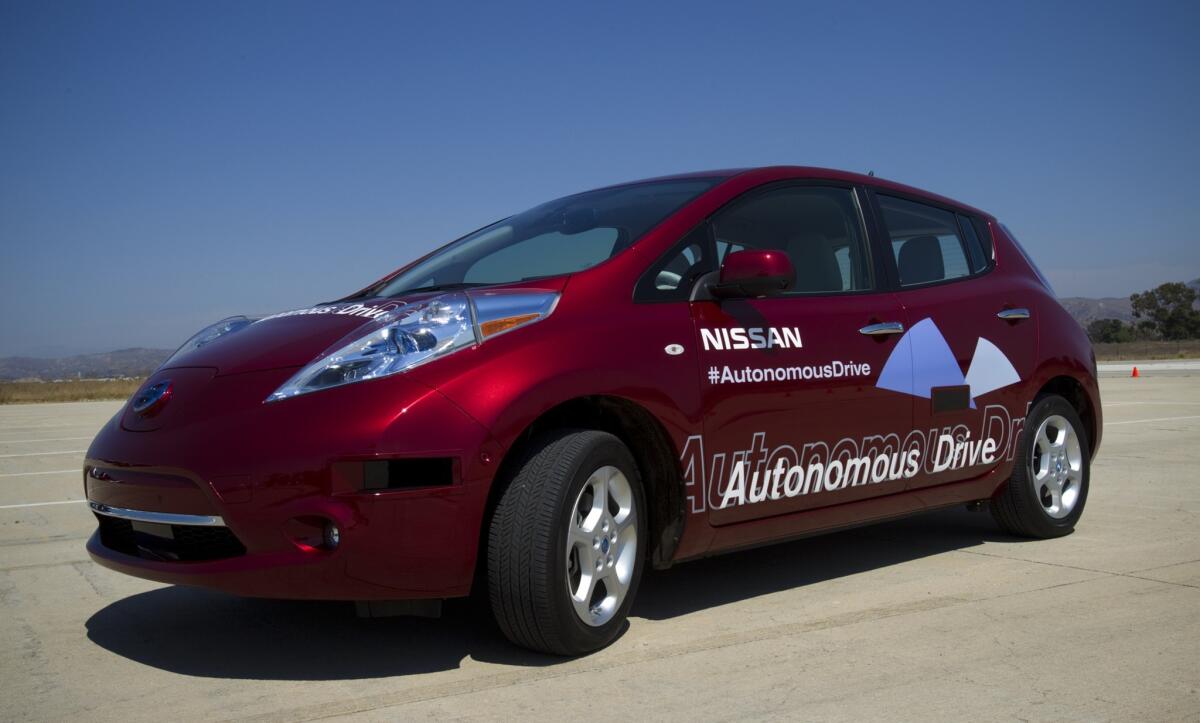Nissan will roll out cars that use autopilot to park, change lanes

- Share via
Nissan plans to introduce a series of autonomous driving functions in its vehicles to convince consumers that self-driving cars represent the future of automotive technology.
Carlos Ghosn, the chief executive of both Nissan Motor Co. and Renault SA, said that by the end of 2016 Nissan will start to market cars that can take over some driving functions.
“We are bringing to market a traffic-jam pilot, a technology enabling cars to drive autonomously – and safely – on congested highways,” Ghosn said in a speech to the Foreign Correspondents Club of Japan. “In the same time frame, we will make fully automated parking systems available across a wide range of vehicles.”
The Japanese automaker plans to introduce cars that can autonomously negotiate hazards and change lanes by 2018.
“And before the end of the decade, we will introduce intersection-autonomy, enabling vehicles to negotiate city crossroads without driver intervention,” Ghosn said.
Nissan’s goal is to be the first in the market with “significant” autopilot features, Ghosn said.
The autonomous drive technologies that Nissan plans to introduce will enhance road safety and driving conditions by automating everyday tasks for motorists, he said.
They differ from the Google self-driving car project and experiments by other automakers on completely autopiloted cars. In the Nissan models drivers will remain in control, using the technology to aid the vehicle’s operations, according to Ghosn.
Earlier this year, Google said it plans to test about 200 gumdrop-shaped, two-seat, self-driving cars. The testing program will start later this year, with a handful of early prototypes hitting the roads around the tech giant’s Mountain View, Calif., headquarters.
These first cars will have manual controls for the test drivers to override the cars’ autonomous driving systems, as required by current California law. But Google plans to build the bulk of the cars as fully autonomous — no steering wheel, no gas or brake pedal.
Other automakers, including Ford, Mercedes-Benz, Audi and General Motors, are also testing self-driving vehicles and autopilot technology.
By 2025, as many as 230,000 self-driving vehicles could be sold each year globally, and that number could swell to 11.8 million a decade later, according to a study released this year by IHS Automotive.
Ghosn said there were powerful major socioeconomic trends pushing automakers toward autonomous vehicle technology.
“The first is the rise of global mega-cities, which is increasing the need for innovations to ease congestion, reducing emissions and improve traffic management,” Ghosn said. “Second, demand is growing for in-car communications that meet or exceed the high expectations of the digital generation. Our vehicles must be as connected as the smartphones and tablets that this generation depends upon day in and day out.”
The world’s growing population of seniors also is looking for technology that will that enable them to drive safely, for longer, he said.
Follow me on Twitter (@LATimesJerry), Facebook and Google+







